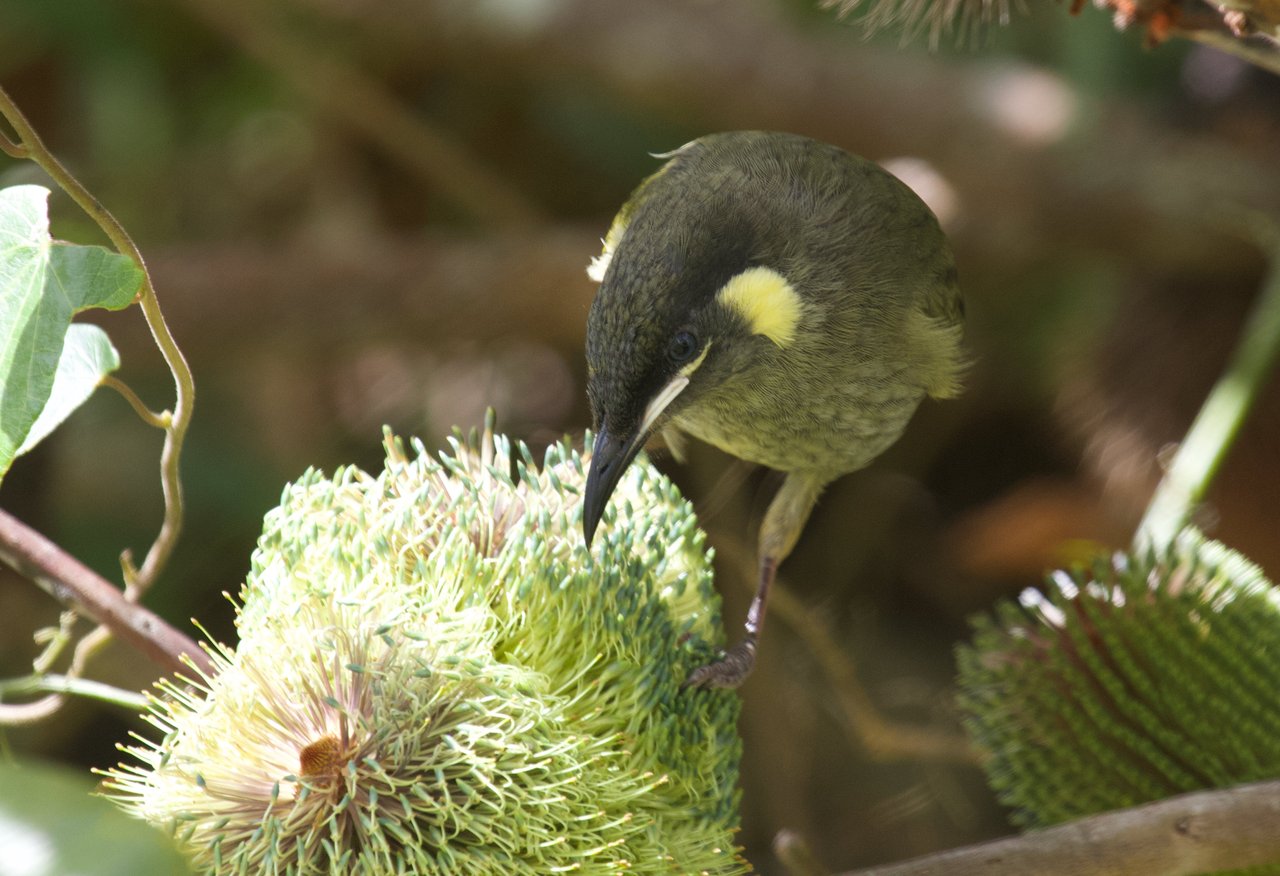The Lewin’s Honeyeater is one of the more common medium bodied honeyeaters on the east coast of Australia with a large range stretching from Melbourne to north of Cooktown. Lewin’s Honeyeaters are olive green with a yellow spot on the ear coverts, grey-blue eyes, and the slight downcurved bill of many other honeyeater species. They weigh between 27–49g and follow Bergmann’s rule of generally being smaller closer to the equator. Most birdwatchers, even those that struggle to identify calls as I do, quickly learn their distinctive call that Brigadier Hugh R. Officer aptly described as “a staccato series of ‘dot-dot-dot’ almost like the rattle of an automatic weapon.” Lewin’s Honeyeaters are generally found in rainforest and wet sclerophyll but can be found in a wide range of ecosystems near their preferred habitat.
The species was first described and painted as the “Yellow-eared Honey-sucker” in John William Lewin’s 1808 book Birds of New Holland with their Natural History, but in 1837 the species was renamed to honor Lewin by Swainson. All three subspecies of Lewin’s Honeyeater occur in Queensland: M. lewinii lewinii occurs from the south of the range in Victoria to the Rockhampton region, M. lewinii mab occurs from Rockhampton to Cooktown, and M. lewinii amphochlora occurs as an isolated population in the McIlwraith Ranges of Cape York. This subspecies, also known as the McIlwraith Range Lewin’s Honeyeater, is listed in The Action Plan of Australian Birds 2020 as vulnerable. It is an isolated population with no records or surveys done in the area since 2009 and is considered susceptible to climate change as the population is primarily found above 650 metres. This does not leave much habitat to move up into as temperatures rise at lower elevations. Although climate change is considered the only current threat, as much of the range is now protected in Kulla McIlwraith Range National Park, the lack of any recent monitoring of the subspecies is concerning.

In Australia the Meliphaga clade also includes the less closely related Kimberley Honeyeater (M. fordiana) in Western Australia and the White-lined Honeyeater (M. albilineata) in the Northern Territory. There are also six additional species in the clade that occur in East Timor, Papua New Guinea, and Indonesia. This clade is considered to have cryptic diversity: species with very similar morphometric characteristics, but significant genetic diversity, co-existing in the same ecosystem. The three species occurring together in Far North Queensland is a good example of cryptic diversity. Lewin’s are physically the largest member of the clade in Australia, but size can be difficult to determine in the field.

Lewin’s have diverse preferences in their diet. They have the largest foraging niche size of the Meliphaga honeyeaters and the seventh largest of the Australian honeyeaters. The Meliphaga clade is the most frugivorous of the Australian honeyeater clades, and all members are known to consume fruit. The Lewin’s is the most frugivorous Meliphaga honeyeater, and the second most frugivorous honeyeater in Australia after the Painted Honeyeater (Grantiella picta). Up to 25% of the Lewin’s preferred diet is native fruits, and an eleven-year study in Lamington National Park from 1985 to 1995 recorded them eating 60 different fruit species. Lewin’s consume small fruits whole, but also pick apart and consume larger fruits that are too big to swallow. They rely on nectar less than the other members of their clade with it only making up 19% of the diet. The remainder of the diet is made up of a variety of invertebrates and seeds.
Despite being common, the social organization, behaviour, and movements of Lewin’s Honeyeaters have not been well studied. They are generally found in ones or twos, but sometimes small groups of up to ten converge when feeding. Lewin’s Honeyeaters can be very aggressive to other species, including other Lewin’s Honeyeaters, when defending food or breeding territories. They build typical honeyeater cup-shaped nests and prefer to nest in dense foliage near water.

Lewin’s are also generally thought to be sedentary, but some seasonal, local movements have been recorded. On my Mt. Nathan property at the foot of Mt. Tamborine, there are more Lewin’s present in the winter months which makes me suspect there is some local altitudinal migration occurring. A very short, 31-day radiotracking of one individual in January and February of 2021 at Blue Gum Hill Regional Park to the west of Newcastle, NSW estimated a home range of 10–11 ha. for that individual. This was a good proof of concept initial investigation, but it would need to be followed up with more individuals over a longer time period to say anything meaningful about the species typical range and seasonal movements. Although the Lewin’s Honeyeater is a common species that most SEQ birdwatchers easily identify, there are many questions that still need to be researched.
References:
- Church, R. J. 1997. Avian Frugivory in a Subtropical Rainforest: Eleven Years of Observation in Lamington National Park. The Sunbird. pp. 85-97.
- Fraser, I. and Gray, J. 2013. Australian Bird Names. CSIRO Publishing. pp. 197-198.
- Higgins, P.J.; Peter, J. M.; Steele, W. K. (2001). Handbook of Australian, New Zealand & Antarctic Birds Volume 5 Tyrant-flycatchers to Chats (1st ed.). South Melbourne, Australia: Oxford University Press. pp. 685-696.
- Little, G. 2022. A short-term radiotelemetry study of movements by a Lewin’s Honeyeater. The Whistler. 16 (2022) pp. 64-65
- Norman, J. A., Rheindt, F. E., Rowe, D. L., and Christidis, L. 2006. Speciation dynamics in the Australo-Papuan Meliphaga honeyeaters. Molecular Phylogenetics and Evolution 42 (2007) pp. 80-91
- Officer, B. H. R. 1971. Australian Honeyeaters. Bird Observers Club. pp. 42-44.
- Shoo, L.P. and Garnett, S. T. 2021. Mcllwraith Ranges Lewin’s Honeyeater Meliphaga lewinii amphochlora In The Action Plan for Australian Birds 2020. CSIRO Publishing. pp 615-617.
- Wagner, S. K. 2015. Foraging Behavior, Behavioral Flexibility, and Range Size of Australian Honeyeaters (Meliphagidae). University of Colorado PhD Thesis.


